9 Best Calendly Alternatives: Your Go-To List for 2024

Mihael Cacic
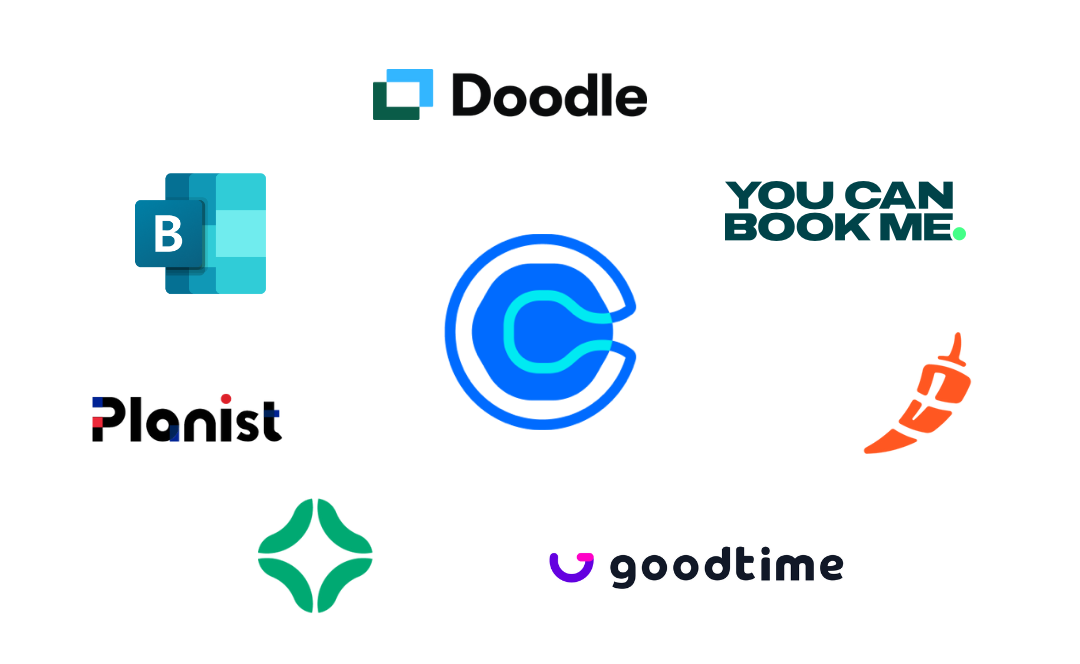
Contents
- Calendly alternatives
- All Calendly Alternatives
- YCBM - Best Alternative For Highly Personalized Booking Experiences
- YCBM vs Calendly
- GoodTime - Best Alternative For High Volume Recruiters
- GoodTime vs Calendly
- Chilipiper - Best Alternative For Reaching Out To Hot Leads
- Chilipier vs. Calendly
- Microsoft bookings — Best Alternative For Simple Booking Requirements
- Microsoft Bookings vs Calendly
- Doodle — Best Alternative For Group Meetings
- Doodle vs. Calendly
- Clockwise — Best Alternative For Protecting Focused Work
- Clockwise vs Calendly
- Acuity Scheduling—Best Alternative For Client Management
- Acuity Scheduling vs Calendly
- Zoom Scheduler—Best Alternative For Scheduling Zoom Meetings
- Zoom Scheduler vs Calendly
- HubSpot Meeting Scheduler—Best Calendly Alternative For HubSpot CRM users
- HubSpot Meeting Scheduler vs Calendly
Calendly Alternatives
Calendly is one of the most popular scheduling tools due to its premium features. Yet businesses today need more flexibility and Calendly can’t cater to every specific booking need. That’s why we’ve compiled this list of 9 Calendly alternatives according to different use cases.
We tested and rated each tool based on its:
- Ease of use
- Integrations
- Value for money
- Booking page customization
Best Calendly Alternatives: Executive Summary
You’ll get disrupted by meetings the least with Clockwise.You’ll get the most lead qualification tools using Chili Piper.
You’ll be able to create better booking experiences if you switch to YouCanBookMe.



Buying Guide & How We Rate The Tools
Every booking tool has a “specialty” that makes it ideal for a specific audience. However, all scheduling apps have four basic dimensions, and we’ve used those to curate this list.
Ease of use: This score reflects how easy the tool is to use and how quick it is to learn. This is especially important if you’re looking for a tool for your team, as the quicker everyone can learn it, the faster will your productivity increase.
Integrations: How well can the tool integrate into your existing tech stack or workflow?
Value for money: Based on its features, is the tool reasonably priced?
Customization: Your booking page should reflect your brand. This score refers to how much freedom a tool gives you in customizing your booking page (in terms of colors, logos, footer, embedding, etc.).
Note: low scores aren’t always bad.
Again, each tool has a specialty. For example, if a tool is made for large enterprises, it’s going to be inherently more complex to use. So at the end of the day, it all comes down to determining the combination of features you want out of your booking tool.
Now let's walk through a mini-review of each.
Common Reasons Users Switch from Calendly
There’s always a reason people want to make the switch from tools like Calendly, and before we could present you with this list of Calendly competitors, we needed to dig into the why.
Here are the top 3 reasons users choose to switch or opt for a different scheduling tool than Calendly:
1. Cost
Calendly’s cost can quickly add up, especially when you have a large team and need to pay a separate fee for every user. Some users don’t believe the features offered are worthy of the price tag.
As one Calendly user explains:
|
“With so many similar products and services, I struggle to see the value in the current pricing system. Perhaps I am not a heavy enough user to take full advantage of the suite of options, but in recent months, I have not found any distinctive benefit to maintaining an upgraded account.” |
2. Lack of flexibility and customization
When examining user reviews, Calendly’s limited customization was brought up frequently by users who switched to other platforms.
For example, one YouCanBookMe user describes:
|
“I've used other calendaring services, like Calendly, before, and I prefer this. I feel like I'm able to do a lot more with it in terms of types of meetings, length of meetings, etc . I'd recommend trying the program, and telling the support team what you want, as they are extremely helpful in getting things set up exactly as you want them to be.” |
A current Chili Piper user adds:
|
“The product has amazing capabilities. So much better than using Calendly or similar. You'll have total control over your lead flow, round-robins, forms, and more. Why settle for something else when you can have something that is so customizable that it can fit nearly any scenario?” |
3. Doesn’t match user needs
Choosing the right scheduling tool can be a pretty personal process. Although most booking apps work in a similar manner, each one has unique capabilities and features that others lack.
Some are tailored to small teams while others to big enterprises. Some are created for sales teams, and others for service-based ones. In the end, make sure to choose the tool that matches your needs and preferences.
For example, here is why one user switched from Calendly to Acuity:
|
“Calendly is more for personal meetings. Acuity is better for paid room reservations.” |
Free Calendly Alternatives
As you will notice, not every scheduling tool offers a free plan. And even if they do, not every free plan is created equal.
If you’re on a tight budget, consider these top 3 free scheduling apps, all offering a booking alternative that costs nothing and yet packs a powerful punch:
- YouCanBookMe—With YouCanBookMe’s free plan, you can create your own booking page, integrated to a calendar of your choice. You’ll be able to customize it with your own logo and text, send personalized confirmation emails and SMS, take payments for meetings, and add a booking form.
- HubSpot meeting scheduler—This meeting scheduler is always free, and integrates deeply with their CRM. On the free plan, you can also integrate your calendar, add custom colors, and even manage scheduling for your entire team.
- Setmore—Although not included elsewhere on this list of alternatives to Calendly, if you’re looking for a powerful free plan, Setmore is worth a quick mention. It’s a good free Calendly alternative for appointment-based businesses, offering branded booking pages, online appointments, and website embedding.
All Calendly Alternatives
Easily create customized booking pages for your multinational team, with smart language auto-detection. The booking pages support 44 languages and allow you to fully customize every step of the booking experience to fit your exact needs. Read more about YouCanBookMe
Best alternative for recruiting teams looking to hire at scale. Offers a range of applicant engagement features but has a steep learning curve. Read more about GoodTime
ChiliPiper automatically qualifies leads and routes them to the best representative as soon as they express interest in a meeting. Read more about Chili Piper
Microsoft’s own scheduling tool with basic features. Ideal for existing Office 365 users with simple scheduling needs. Read more about Microsoft Bookings
Doodle places the most focus on team meetings, making it the best alternative for scheduling group and internal team meetings in a more casual setting. Read more about Doodle
Automatically determines the best meeting times for you to maximize your focus time and minimize distractions. Read more about Clockwise
Created for appointment and service-based businesses, Acuity offers advanced client management features alongside scheduling.Read more about Acuity Scheduling
Zoom’s scheduling add-on is designed to simplify scheduling Zoom and in-person meetings. It’s the newest scheduling tool on the list.Read more about Zoom Scheduler
HubSpot’s meeting scheduler is deeply integrated into the CRM and is included in all HubSpot plans, even for free users. Read more about Hubspot meeting scheduler
1. YouCanBookMe (YCBM)—Best Calendly Alternative for Small Business

YouCanBookMe (YCBM) was founded in 2011 and its goal has always been to create excellent booking experiences.
It’s the only scheduling tool that offers completely customizable booking pages, and auto-detects and adjusts booking page language based on your customers’ location. YouCanBookMe supports 44 languages (including left-to-right and character-based scripts like Arabic and Japanese).
YouCanBookMe’s booking pages can include logos, footers, and custom colors. It also offers custom shorthand codes that let you automatically personalize notifications, automatic reminders, and follow-up messages via SMS or email.
Finally, YouCanBookMe's workflow is non-modular — you create booking pages in a single editor that includes a live preview. This means the process is fast and easy, making YouCanBookMe ideal for non-technical people and small teams that don’t need complex page creation workflows.
So who is the ideal user of YouCanBookMe? Well, if you’re a small business of up to 20 people that wants to deliver highly personalized booking experiences to bring your professional services to clients all over the world, YouCanBookMe is the way to go. Check out this interactive demo tour and see how simple it is for your customers to start scheduling appointments!

YouCanBookMe paid plans start at $9 per month; Calendly starts at $12 per seat per month

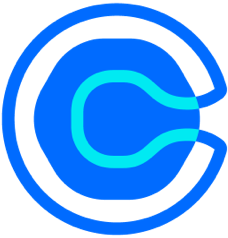
$9/mo, 2 calendars, customizable booking pages and reminders
-
$18/mo, Round-robin, centralized billing, and more
Both tools are affordable for individuals who need basic meeting scheduling features. But if you need advanced features for a team, like follow-up and no-show notifications, advanced workflows and being able to accept or reject bookings, Calendly can be twice as expensive as YouCanBookMe:
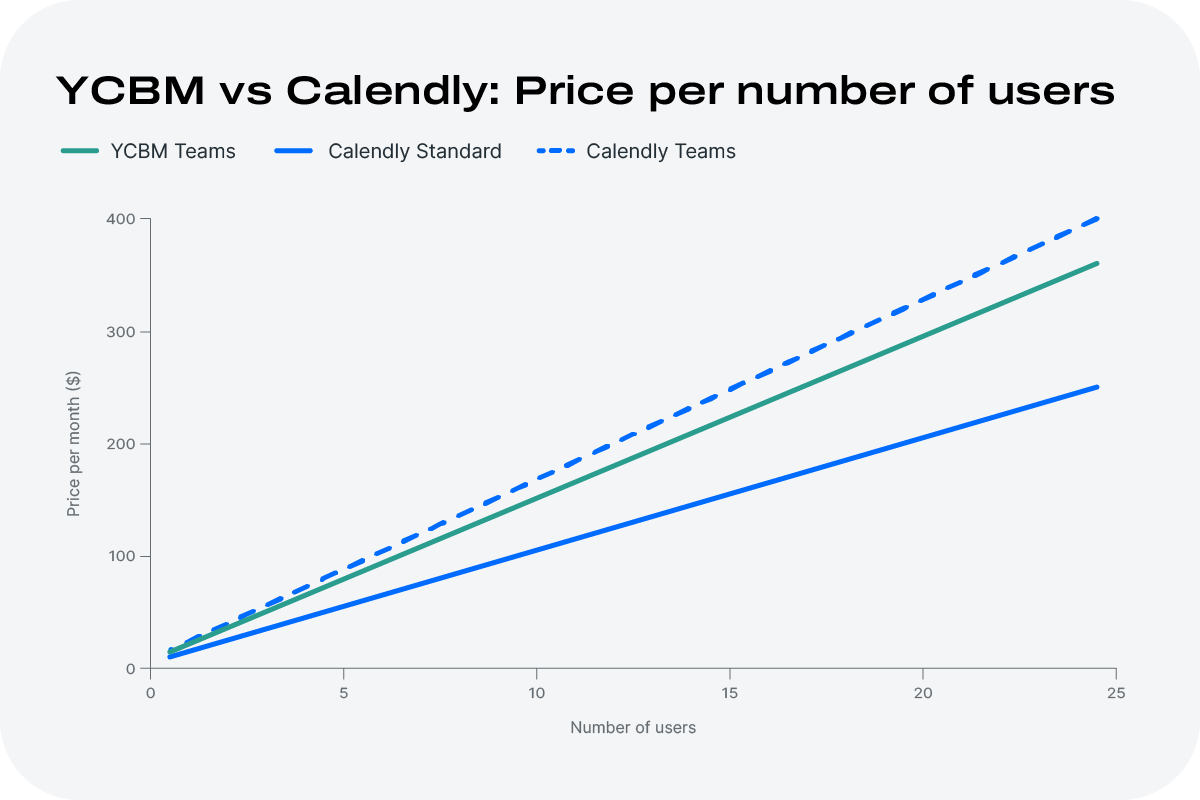
YouCanBookMe vs Calendly
YouCanBookMe has a non-modular workflow, while Calendly has a modular system
YouCanBookMe combines all modules for creating pages (booking forms, notifications, style, and appearance) in its booking page creator tool. That, and the fact that it has a live page preview, makes it easier and faster to use than Calendly.
On the other hand, Calendly has modular tools — organized in different tabs. That makes it confusing for beginners and annoying to create booking pages if you’re a small team, but it’s great if you’re an admin managing calendars for a big corporation.
YouCanBookMe offers more personalization features than Calendly
Here are some major differences between the two:
- YouCanBookMe lets you choose how you display your availability - between a month view and two different day views, which Calendly’s booking pages don’t offer.
- YouCanBookMe can auto-detect user location and adjust the booking page grid language with 44 supported languages, compared to only 9 language options available with Calendly.
- YouCanBookMe offers unlimited custom colors for booking pages, while Calendly and other YouCanBookMe alternatives only have a few select choices (only on the premium plans).
- YouCanBookMe gives you a custom domain, and lets you add a footer to booking pages that can contain your social accounts, website URL, contact details, and other branding information.
- YouCanBookMe offers completely personalizable automatic notifications, where you can stylize email text, add your logo and images to emails, include hyperlinks, and dynamically personalize messages for each customer using their information from the booking page or website forms

Use YouCanBookMe if:
- You want highly personalized booking pages that can be adapted to give your bookers the best scheduling experience.
- You have team members or customers who speak different languages and can benefit from auto-translated booking pages.
- You want an easy-to-use tool with a straightforward, non-modular workflow to help you create booking pages within minutes.
Get started with YouCanBookMe for free. Or opt for the 14-day free trial that gives you access to all the paid features, no credit card required. If you're still unsure whether YouCanBookMe is better for you than Calendly, read our in-depth comparison of Calendly vs YouCanBookMe here.




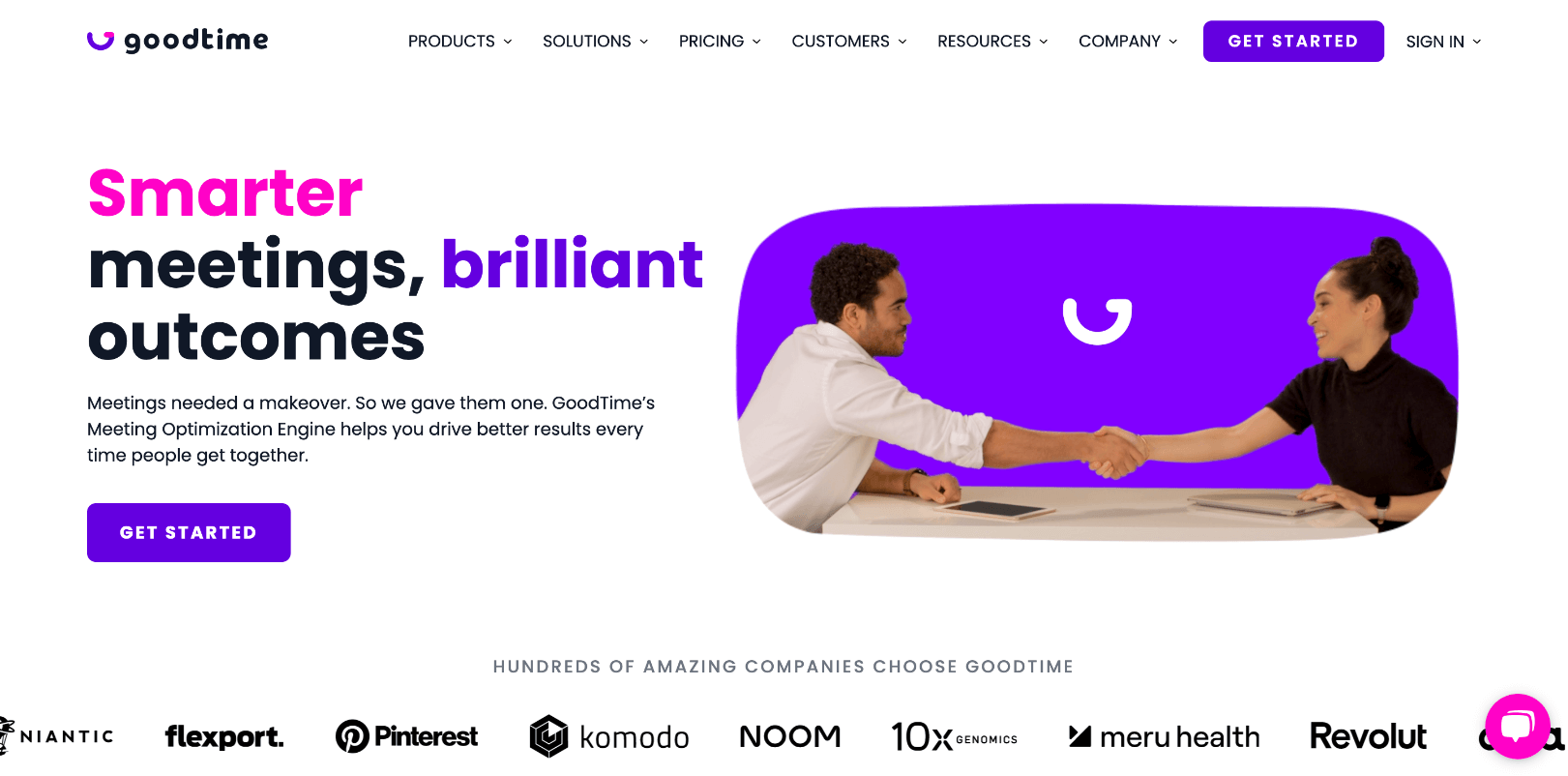
GoodTime was developed back in 2015 after its co-founders Ahryun, Jasper, and Peter met at a hackathon. Their goal was simple: improve job interviews.
It’s a full-blown appointment scheduling software, focused on improving the lives of recruiters with features like:
- Find free time slots for all interviewers and match them with free slots on candidates’ calendars.
- Connect with candidates directly with SMS notifications to provide a fast, personalized experience.
- Train interviewers by automatically adding shadowers to interviews.
- Get an overview of every recruiter’s schedules, reschedules, cancellations, and updates within a single dashboard.
- Integrate interview scheduling with applicant tracking systems (Greenhouse, Lever, Workday), video conferencing tools (Zoom, Google Meet, Microsoft Teams), e-signature platforms (DocuSign), and collaborative coding platforms (CoderPad, HackerRank).
Because of these recruitment-oriented scheduling features, GoodTime is ideal for recruiting teams that hire on a large scale, where good coordination and personalization are otherwise difficult.
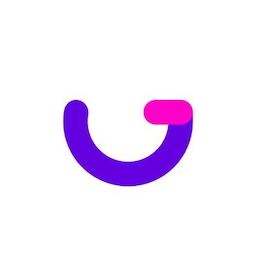
GoodTime vs Calendly
Calendly is geared towards large teams with complex workflows that need to schedule internal or external one-on-one meetings. But it doesn’t offer any dedicated recruiting features like GoodTime.
Meanwhile, GoodTime offers two products:- Hire - Powerful tools for recruiting and interviews (has a steep learning curve)
- Meet - Simple internal team meeting scheduling link
GoodTime Pricing
GoodTime Meet offers three pricing plans — Starter, Professional, and Enterprise. There are minor differences between the three, such as increased limits on tags, templates, training paths, and the number of integrations. The Enterprise plan allows data access via the API and custom security assessments.
You’ll have to contact their sales team to find out custom pricing for the Meet plan.
Use GoodTime if:
- You are a recruiter and need to integrate with specific recruitment tools to schedule interviews
- You want a scheduling solution that’s more focused on external scheduling instead of internal team meetings.
- You can benefit from AI-powered insights into how to improve your hiring process and hit hiring goals.
3. Chili Piper—Best Calendly Alternative for Reaching Out To Hot Leads
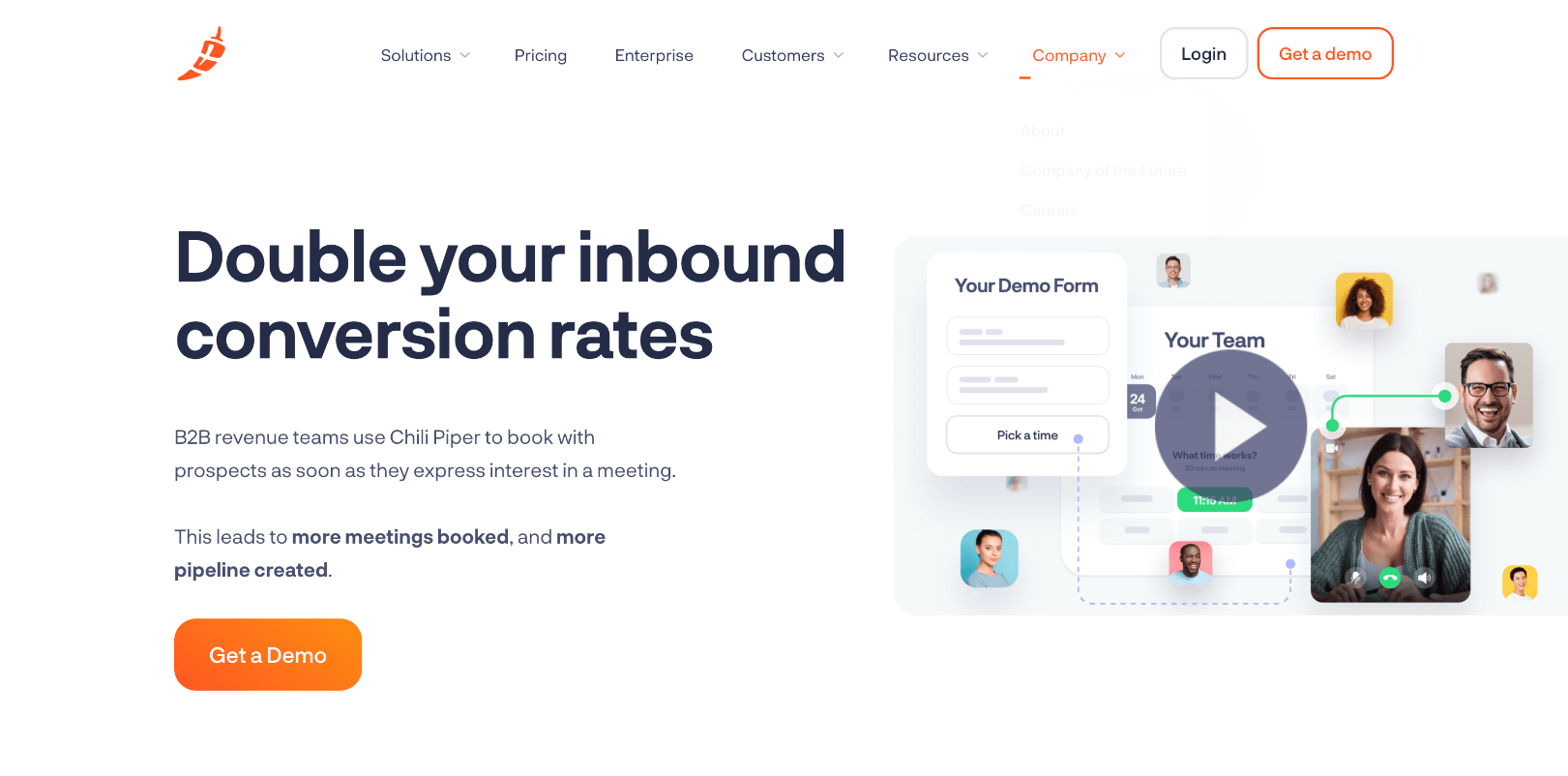
Chili Piper was born in 2016 when someone asked its co-founders Alina and Nicolas to help with their round robin distribution of meetings.
It’s a unique scheduling platform that offers four different solutions — Form Concierge, Distro, Handoff, and Instant Booker. Instant Booker is its scheduling tool and is very similar to Calendly. But what makes the platform unique is its ability to qualify leads and schedule in-context meetings via Form Concierge and Distro. Form Concierge qualifies and routes leads to the right rep through web forms, while Distro does the same for content and webinar leads. On the other hand, Handoff helps you automate lead routing to a different rep (based on size or location, for example).
Given its wide range of tools, Chili Piper is ideal for small to medium-sized sales teams looking to qualify leads and schedule a meeting with them at the same time.
Chili Piper vs. Calendly
When comparing Chili Piper vs. Calendly, you’ll see that the scheduling features are mostly the same. But there are six important differences:
- Many users report Chili Piper is difficult to set up compared to Calendly.
- Calendly has a dedicated iOS mobile app.
- Calendly offers 100+ native integrations, while Chili Piper has more limited integrations with 59.
- Chili Piper can’t accept payments via Stripe or PayPal.
- The tool is more expensive than Calendly and most Chili Piper alternatives.
- Chili Piper has better support for booking physical locations.
But keep in mind, you won’t get any of Chili Pipers’ lead qualification key features like Form Concierge and Distro with Calendly.
Chili Piper pricing
The tool sells its solutions separately as follows:
- Instant Booker — $22.50/user/month (1-click scheduling over email, group booking links, unlimited meeting types)
- Handoff — $37.50/user/month (includes all Instant Booker features)
- Form Concierge — $45/user/month (includes all Instant Booker features)
- Distro — $30/user/month
You can also purchase a Form Concierge + Distro bundle.
Use Chili Piper if:
- You are a small sales team looking to hold in-context meetings and engage your leads more effectively.
- You’re willing to spend a lot more than typical for scheduling tools.
- You don’t need to collect payments for appointments.
Microsoft Bookings was released in March 2017 and comes as part of a Microsoft 365 subscription.
It’s a relatively straightforward scheduling tool with simple features like:
- Email and SMS notifications
-
Integrations with other Microsoft tools like Outlook
- Custom logos for booking pages
- Custom booking page colors
These limited features are OK for simple booking but they’re not enough if your business is highly dependent on scheduling and needs advanced features, and it doesn't work with Google calendar, or offer a Zoom integration. This makes Microsoft Bookings ideal for a very specific audience — companies with simple scheduling needs that already have a Microsoft 365 subscription.
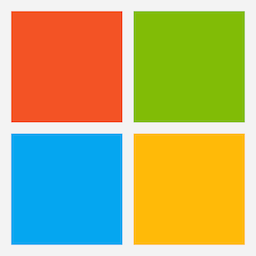
Microsoft Bookings vs Calendly
If you take Calendly’s steroids away, you get Microsoft Bookings. That’s because Microsoft Bookings does the same things as Calendly but is way more bare-bones. Let's take a closer look at MS Bookings vs. Calendly:
- Both apps support video conferencing tools, but Calendly integrates with Google Meet, Zoom, Microsoft Teams, Webex, and GoToMeeting, while Microsoft Bookings only supports Teams.
- Both tools support reporting. But Microsoft Bookings includes only four months of data at a time and you have to download crude data as a spreadsheet. Meanwhile, Calendly offers useful insights like top performers, popular meeting times, and busiest meeting days automatically.
- Both tools integrate with other online tools. But Microsoft Bookings supports only other Microsoft tools, while Calendly offers over 100 native integrations.
Calendly also supports workflow automation, where you can program a meeting script and repeat it. For example, if you want to automatically send your sales reps the recording of a demo after it's over. This is not supported in Microsoft Bookings.
Microsoft Bookings pricing:
Microsoft Bookings comes as part of a 365 subscription, which starts at $6/user/month and goes up to $22/user/month on its most advanced plan.
Use Microsoft Bookings if:
- You have simple scheduling needs and don’t need fancy features like workflow automation.
- You’re already paying for a Microsoft 365 subscription.
5. Doodle—Best Calendly Alternative For Group Meetings
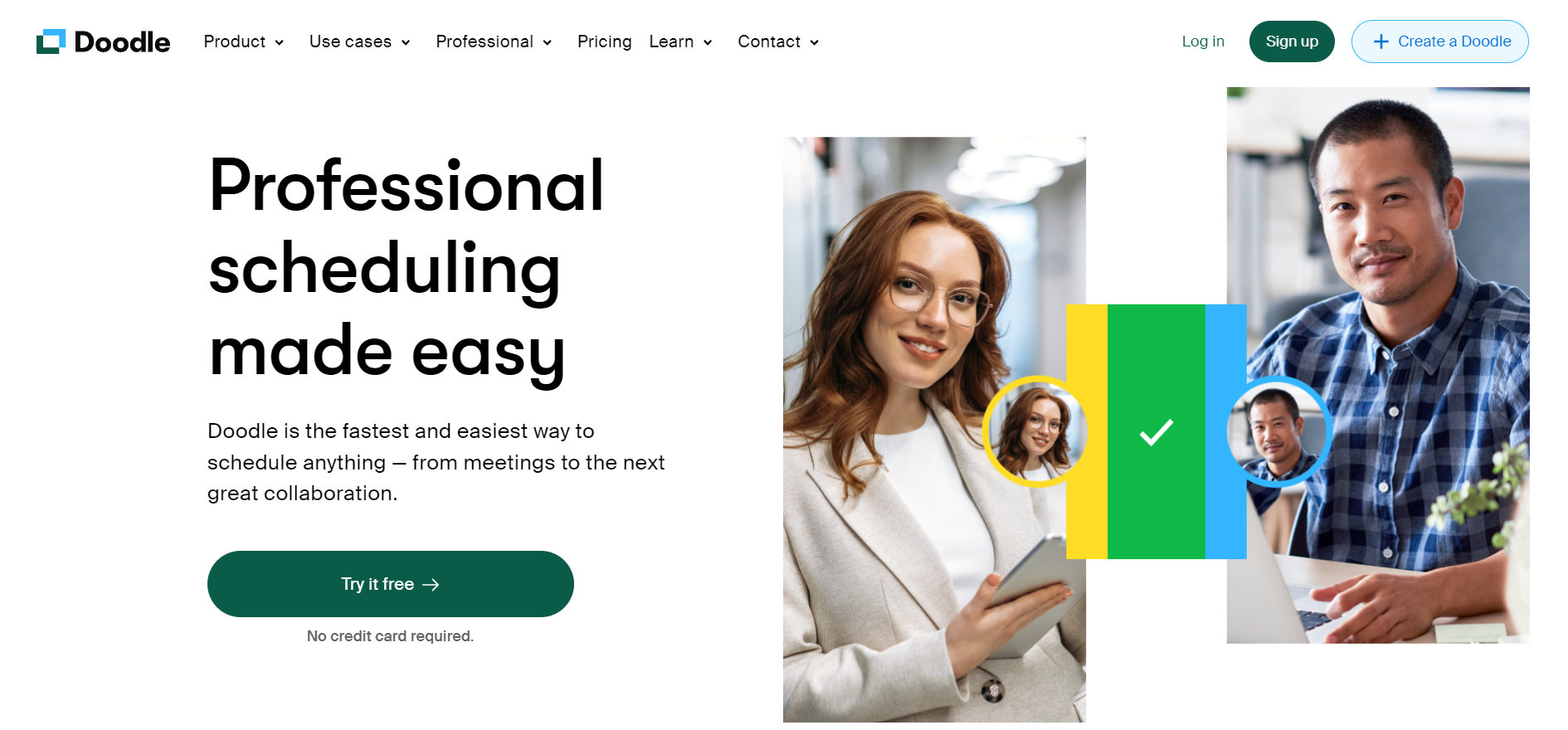
Doodle’s founding story goes all the way back to 2007 when the founders Michael and Paul wanted a way to meet with groups of people without endless back and forth emails. It got traction in universities and quickly turned into a business that now serves over 30M users.
It’s a simple but powerful scheduling tool that offers all “classic” features like:
- Meeting buffers
- Custom available times
- Automatic time-zone detection
- Automatic email reminders
But what makes this tool truly special compared to Doodle competitors is its focus on group scheduling. It does that by offering user-friendly group polls that team members can answer to determine when everybody is free.
This makes Doodle an ideal tool for small businesses that are looking to streamline and organize internal team meetings in a more casual setting.
Doodle vs. Calendly
Here are some important differences in the Calendly vs. Doodle matchup:
- Calendly supports a wider range of video conferencing tools, including GoToMeeting, Zoom, Webex, MS Teams, and Google Meet.
- Doodle supports only Zoom and MS Teams on the paid plan.
Doodle offers 9 native integrations, while Calendly offers over 100. - Doodle doesn’t offer 1-1 scheduling on its free plan, while Calendly does that and a lot more.
- Calendly offers email and browser plugins, allowing you to schedule meetings from Chrome, Outlook, and Gmail. Doodle supports only Outlook on its paid plans.
- Calendly has a better, more professional user interface because it’s geared towards enterprise businesses. Meanwhile, Doodle has a more casual interface, meant for the casual consumer
Doodle pricing
- Free Plan: Unlimited group polls, 1 booking page
- Pro Plan ($14.95/user/month): No ads, Unlimited booking pages,
Unlimited 1:1s, Custom branding, Video conferencing - Team Plan ($19.95/user/month): Roles and permissions, Activity reports, Admin Console, Collective event scheduling
Use Doodle if:
- You’re looking for a tool to schedule group meetings.
- Your team members are in different time zones and can benefit from automatic time-zone adjustment.
- You use Zoom or MS Teams for video conferencing.
6. Clockwise—Best Calendly Alternative For Protecting Focused Work
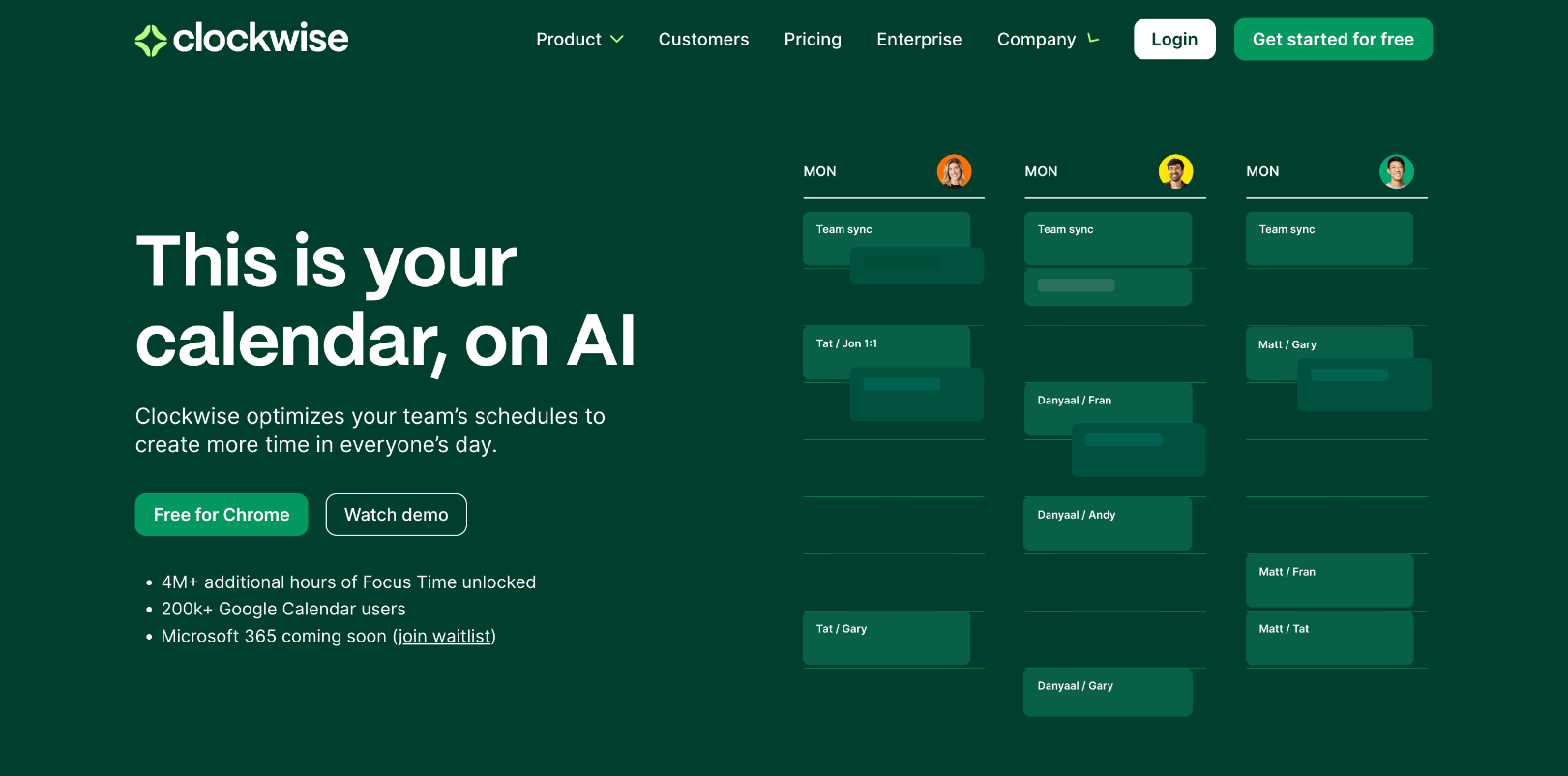
Clockwise was founded in 2016 by Gary Lerhaupt, Matt Martin and Mike Grinolds. And the trio calls their tool a “time orchestration platform”.
Clockwise allows users to schedule meetings at the most non-disruptive time using “Clockwise Links”. These are scheduling links that display the least disruptive meeting times to your bookers, and then suggest the most appropriate time according to their calendars. The tool considers the following factors when determining the best meeting times and duration for invitees:
- Focus time
- Preferred meeting hours
- No meetings day
- Consecutive meetings
- Lunch time
- Travel time
It also has a handy group meeting feature, which aggregates your team members’ availability and only displays times when everyone is available to bookers.
Given these features, Clockwise is ideal for individuals and teams looking for a personal time-management assistant (without the actual assistant).

Clockwise vs Calendly
Since Clockwise is not one of the traditional scheduling apps, you don’t get features like time-zone adjustment, payment collection, and branding or customization options. In addition, Clockwise offers only two integrations — Slack and Asana. Finally, the tool supports only Google Calendar, unlike Calendly which also works with Office 365, Exchange Calendar, and iCloud Calendar.
Clockwise Pricing:
Clockwise offers 3 pricing plans:
- Free — 1 custom link, best meeting times highlighted, video conferencing
- Teams ($6.75/user/month billed annually) — unlimited custom links, group scheduling links
- Business ($11.50/user/month billed annually) — at-a-glance team analytics, dedicated support
Use Clockwise if:
- Your team is struggling with time management and focus.
- You don’t need a tool for external appointments
- You don’t need to charge for appointments.
7. Acuity Scheduling—Best Calendly Alternative For Client Management
/Real%20estate%20tools%20blog/Acuity%20Scheduling.png?width=2592&height=1344&name=Acuity%20Scheduling.png)
Founded way back when in 2006, Acuity Scheduling is a booking app designed with service and appointment-based businesses in mind. It’s a useful solution for anyone who isn’t just looking for a scheduling tool, but also a client management software.
Acuity provides a unique set of solutions for businesses that offer paid appointments, including keeping track of client details, creating invoices, setting up flexible payment plans, and incorporating upsell add-ons into checkout.
Like most scheduling apps, Acuity integrates with tools such as Zoom, Google Meet, Zapier, Google Calendar, and Microsoft Calendar. As a bonus, since Acuity was acquired by Squarespace in 2019, it works particularly well with Squarespace websites.

Acuity Scheduling vs. Calendly
There are a few stand-out differences between Calendly vs. Acuity Scheduling:
- Acuity boasts more features tailored for service-based businesses, such as receiving tips, offering memberships, and selling gift certificates.
- Calendly offers a shareable scheduling link and routing feature, while Acuity doesn’t.
- Acuity has native features that handle billing, invoicing, and online payment processing, while Calendly offers third-party integrations that do the same.
- While Calendly has more overall integrations (over 100), Acuity connects with a handful of handy apps that Calendly lacks, including account and invoicing programs such as QuickBooks, FreshBooks Classic, and FreshBooks Cloud Accounting, as well as ClassPass, ReferralCandy, Reviewrai, and Daylite.
- Acuity is more cost-effective than Calendly for teams of 4+.
Overall, Calendly is better suited for general scheduling needs, while Acuity is geared toward service-based businesses and stands out from most Acuity Scheduling alternatives in that category.
Acuity Scheduling Pricing:
Acuity’s plans (billed monthly) include:
- Emerging plan ($20/month) for one member of staff or location
- Growing plan ($34/month) for six members of staff or locations, with appointment packages and subscriptions
- Powerhouse plan ($61/month) for 36 members of staff or locations, with options for in-house developers
Unlike Calendly, Acuity Scheduling doesn’t have a free plan, but does offer a free, 7-day trial.
Use Acuity Scheduling if:
- You’re looking for a scheduling tool with a robust set of client management features.
- You use Squarespace and want a booking app to easily fit into your website.
- You need a scheduling tool built only for service or appointment-based businesses.
Zoom Scheduler is Zoom’s booking extension designed to simplify scheduling Zoom meetings. Released in July of 2023, It’s a pretty new addition to the scheduling scene, especially compared to the other Calendly alternatives on this list.
Similarly to MS Bookings, Zoom Scheduler isn’t a standalone tool; instead, it is an optional add-on to existing Zoom accounts.
However, with that being said, Zoom Scheduler still features a good amount of booking capabilities, such as round-robin scheduling, routing forms, meeting polls, and meeting analytics.
Zoom Scheduler’s main caveat is that it doesn’t connect with any video chat tools other than Zoom.
Zoom Scheduler vs. Calendly
A closer look at Zoom Scheduler vs. Calendly reveals some major differences:
- Aside from Zoom’s main video conference tool, Zoom Scheduler only offers three integrations compared to Calendly’s over 100—Office 365, Outlook, and Google calendars.
- Zoom Scheduler is more affordable than Calendly.
- Zoom Scheduler lacks many features that Calendly offers, including collecting payments for meetings, the ability to embed your booking page on your website, and daily booking limits.
- If you’re already a Zoom user, their scheduler will likely have a lower learning curve than Calendly.
Zoom Scheduler Pricing:
Zoom Scheduler comes included in Zoom’s Business ($21.99/month) and Business Plus ($26.99/month) plans.
If you’re using Zoom’s free Basic plan or Pro plan, you’ll have to pay $4.99 a month (when billed annually) to add the scheduler.
You can also try before you buy with a free, 14-day trial.
Use Zoom Scheduler if:
- You’re already a ride-or-die Zoom user, and don’t want to create any new accounts.
- You only need to schedule in-person or Zoom meetings, and don’t use other video chat apps, such as MS Teams or Google Meet.
9. HubSpot Meeting Scheduler—Best Calendly Alternative For HubSpot CRM users
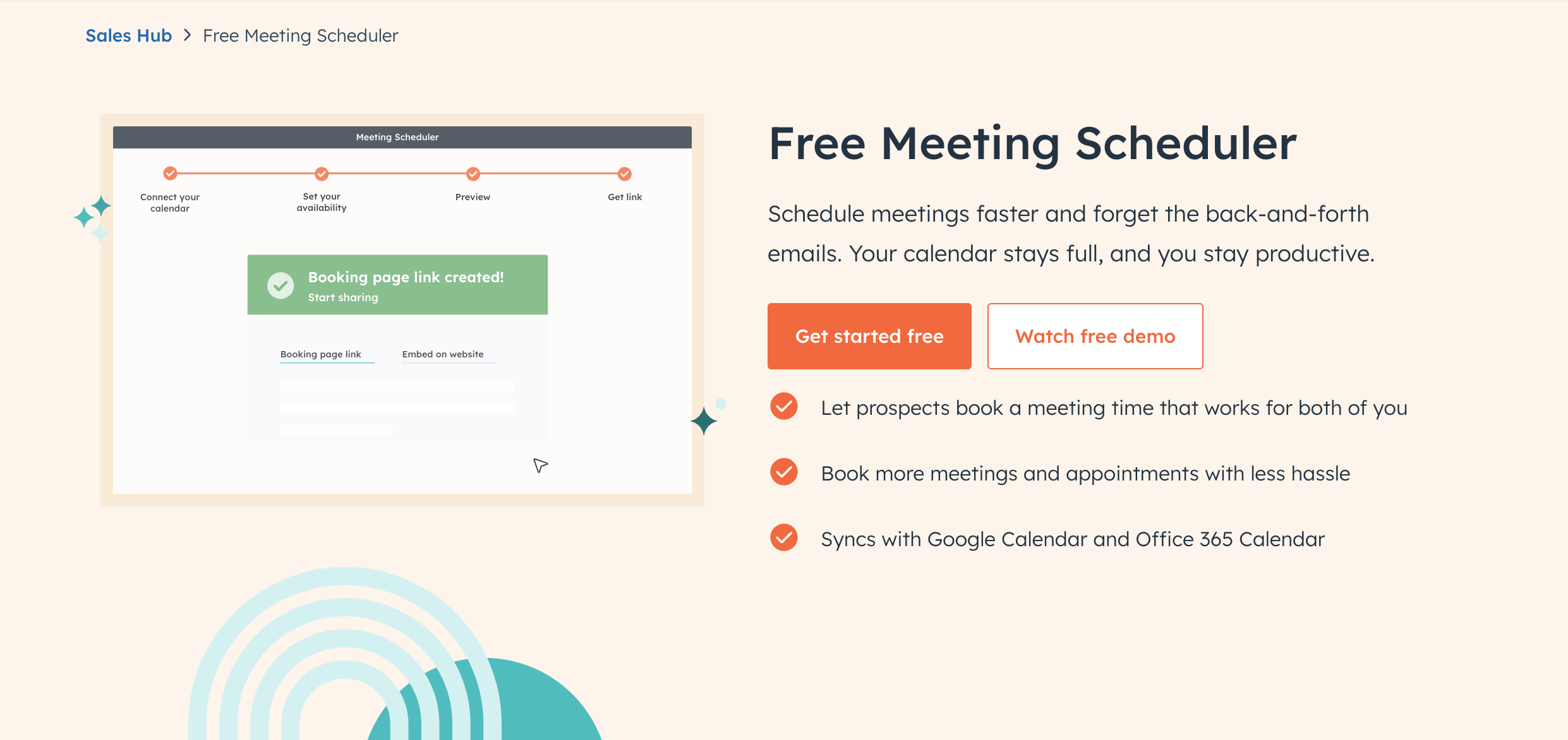
HubSpot Meeting Scheduler is a powerful scheduling tool built directly into HubSpot’s CRM platform. It’s designed to help businesses streamline appointment booking while integrating meeting data with customer interactions in the CRM.
This makes it a great solution for sales, marketing, and service teams that need more than just a scheduling app, but a deep integration with customer relationship management.
Since HubSpot Meeting Scheduler is embedded in the CRM, it automatically logs meeting details, notes, and follow-ups in customer records. This helps teams manage customer interactions and track progress throughout the sales or support process.
HubSpot’s scheduler also supports round-robin scheduling for teams, where leads are distributed evenly based on availability.
HubSpot Meeting Scheduler vs. Calendly
A key difference between HubSpot meeting scheduler and Calendly is HubSpot's focus on CRM integration.
HubSpot’s meeting scheduler automatically logs meetings into its CRM, allowing teams to track customer interactions and automate follow-up actions. Calendly, by contrast, offers a wider range of external integrations and customizations but lacks the deep CRM features that HubSpot offers.
HubSpot Meeting Scheduler is ideal for teams already using HubSpot’s ecosystem, while Calendly is better suited for those seeking a standalone scheduling tool.
HubSpot Meeting Scheduler Pricing:
Free: Available with HubSpot’s free CRM.
Paid plans: HubSpot’s paid tiers unlock more advanced CRM, marketing, and sales features, but the scheduler itself is the same as in the free version.
Use HubSpot Meeting Scheduler if:
- You need a scheduling tool that integrates flawlessly with Hubspot’s CRM to manage sales or customer interactions.
- You’re already using or planning to use HubSpot for marketing, sales, or service.
The final verdict
As you can tell by now, there’s no single best Calendly alternative. It all comes down to what you want out of your scheduling tool. The good news is that many of these alternative providers offer free trials that you can test before ditching Calendly.
But based on our testing, we recommend:
- For individuals, small teams, and businesses looking for a tool to create highly personalized, multilingual booking pages: YouCanBookMe
- For sales teams looking to meet with pre-qualified leads: Chili Piper
- For teams looking to protect their focused work: Clockwise
Subscribe to our newsletter
Get productivity tips, news, articles and resources.

Written by
Mihael Cacic
Mihael Cacic is an independent writer and an expert in comparative content. After graduating from Physics, Mihael left his job as a software engineer developing SaaS products and began writing about them instead. He gets a kick from writing in-depth and objective software reviews, knowing his readers will find the best software for their needs.







